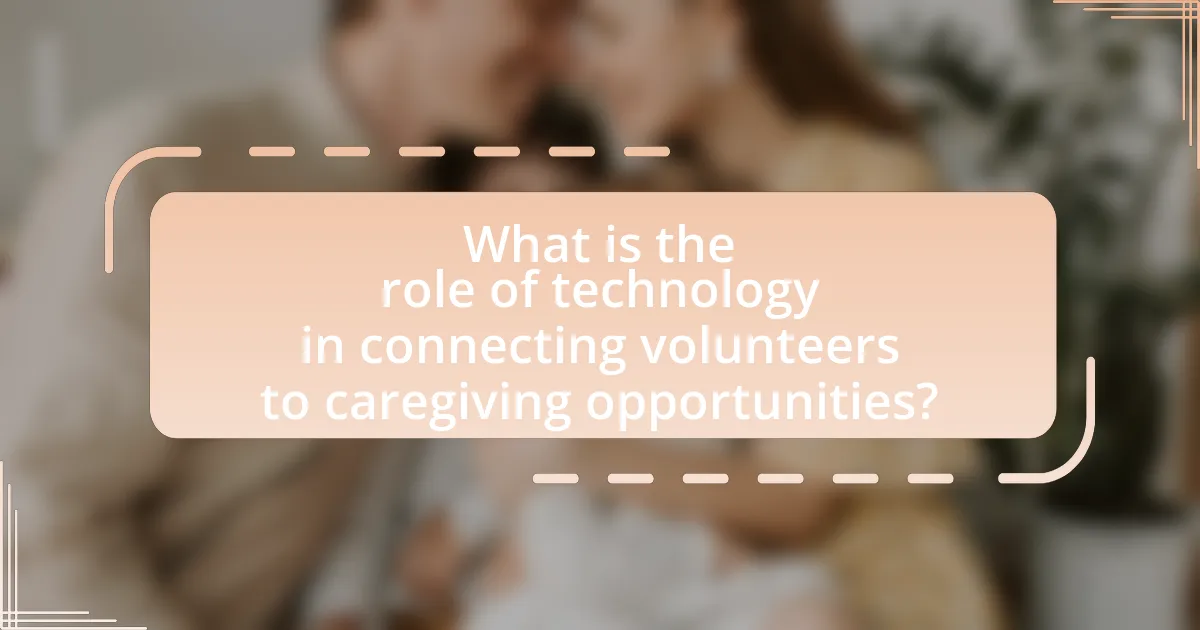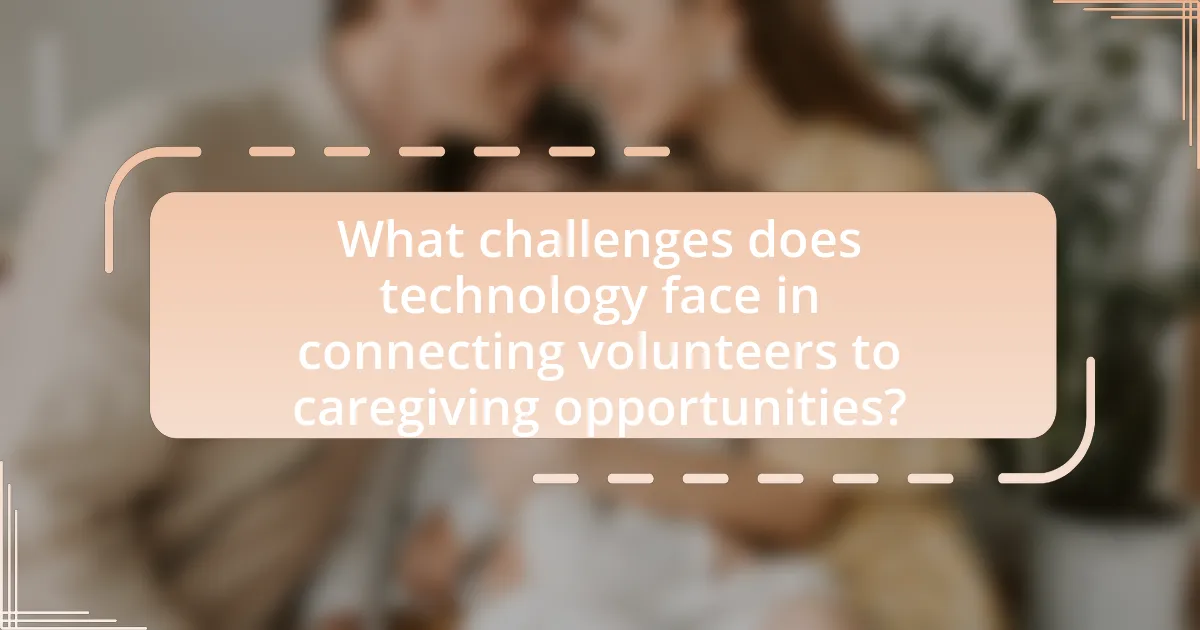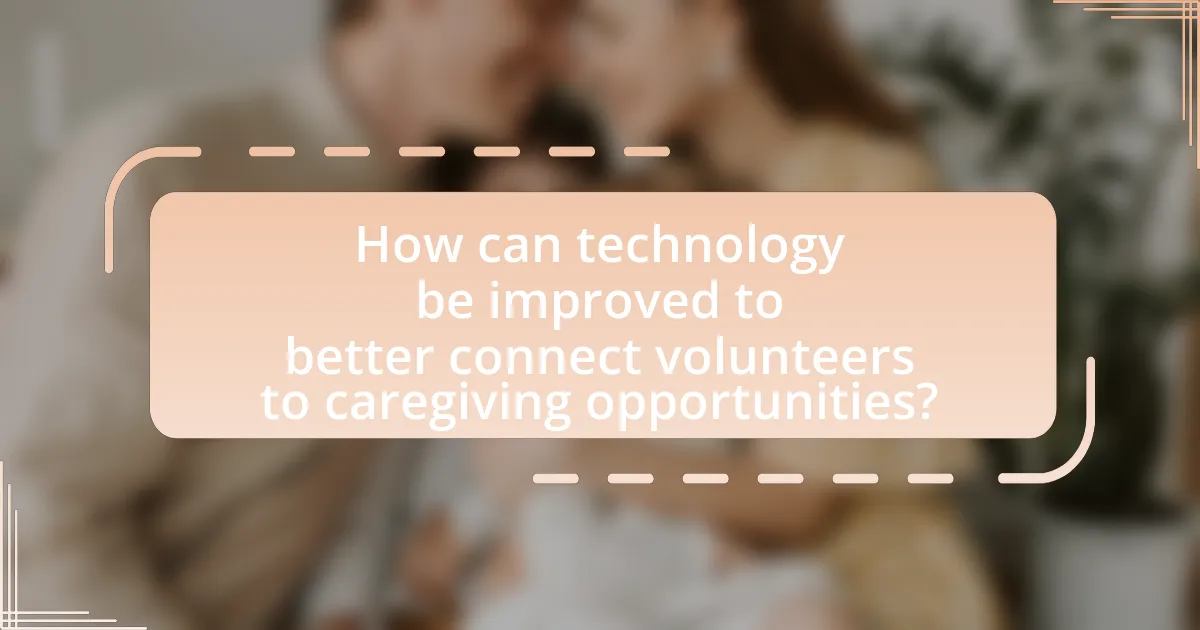The article examines the pivotal role of technology in connecting volunteers to caregiving opportunities, highlighting various platforms such as VolunteerMatch and Care.com that facilitate communication, scheduling, and resource sharing. It discusses how these platforms enhance volunteer engagement through improved accessibility, safety measures, and efficient matching processes driven by algorithms. Additionally, the article addresses challenges such as technological barriers and ethical considerations, while proposing strategies for organizations to optimize technology use and foster supportive online communities for volunteers. Key benefits of technology in volunteer caregiving, including increased retention rates and enhanced coordination, are also explored.

What is the role of technology in connecting volunteers to caregiving opportunities?
Technology plays a crucial role in connecting volunteers to caregiving opportunities by providing platforms that facilitate communication, scheduling, and resource sharing. Online platforms and mobile applications enable organizations to post caregiving needs, allowing volunteers to easily find and apply for opportunities that match their skills and availability. For instance, platforms like VolunteerMatch and Care.com streamline the process by offering searchable databases where volunteers can filter opportunities based on location, type of care needed, and time commitment. This accessibility increases volunteer engagement and ensures that caregiving resources are efficiently allocated to those in need.
How does technology facilitate the connection between volunteers and caregiving opportunities?
Technology facilitates the connection between volunteers and caregiving opportunities by providing platforms that streamline communication and match volunteers with specific needs. Online databases and mobile applications allow organizations to post caregiving opportunities, enabling volunteers to search and apply based on their skills and availability. For instance, platforms like VolunteerMatch and Care.com utilize algorithms to connect volunteers with local caregiving roles, enhancing accessibility and efficiency. This digital approach not only broadens the reach of caregiving opportunities but also allows for real-time updates and feedback, fostering a more engaged volunteer community.
What platforms are commonly used for this connection?
Common platforms used for connecting volunteers to caregiving opportunities include VolunteerMatch, Idealist, and Care.com. These platforms facilitate the matching of volunteers with organizations in need of caregiving services, providing searchable databases of opportunities. For instance, VolunteerMatch has over 100,000 volunteer opportunities listed, making it a significant resource for both volunteers and organizations seeking assistance.
How do these platforms ensure safety and reliability for volunteers?
These platforms ensure safety and reliability for volunteers through comprehensive vetting processes, user reviews, and secure communication channels. The vetting processes often include background checks and verification of credentials, which help to establish trust between volunteers and organizations. User reviews provide feedback on experiences, allowing potential volunteers to make informed decisions based on the reliability of the opportunities. Additionally, secure communication channels protect personal information and facilitate safe interactions, further enhancing the overall safety of the volunteering experience.
What are the key benefits of using technology for volunteer caregiving?
The key benefits of using technology for volunteer caregiving include improved communication, enhanced coordination, and increased accessibility. Technology facilitates real-time communication between volunteers and organizations, allowing for efficient updates and support. Enhanced coordination through scheduling tools and platforms ensures that volunteers can easily find and commit to caregiving opportunities that match their availability. Additionally, technology increases accessibility by connecting volunteers with caregiving opportunities regardless of geographical barriers, enabling a broader range of individuals to participate in volunteer efforts. These benefits collectively lead to a more effective and engaged volunteer caregiving community.
How does technology enhance the efficiency of volunteer matching?
Technology enhances the efficiency of volunteer matching by utilizing algorithms and data analytics to connect volunteers with suitable opportunities based on their skills, interests, and availability. Platforms like VolunteerMatch and Idealist employ sophisticated matching systems that analyze user profiles and project requirements, significantly reducing the time and effort needed to find appropriate matches. For instance, a study by the Stanford Social Innovation Review found that organizations using technology-driven matching systems reported a 30% increase in volunteer engagement and retention, demonstrating the effectiveness of these tools in streamlining the volunteer recruitment process.
What impact does technology have on volunteer engagement and retention?
Technology significantly enhances volunteer engagement and retention by streamlining communication and providing accessible platforms for coordination. Digital tools, such as volunteer management software and mobile applications, facilitate easier scheduling, tracking of hours, and real-time updates, which can lead to a more organized and satisfying volunteer experience. Research indicates that organizations utilizing technology for volunteer management report a 50% increase in volunteer retention rates, as it fosters a sense of community and connection among volunteers. Furthermore, technology enables personalized communication, allowing organizations to tailor messages and opportunities to individual volunteers’ interests, thereby increasing their commitment and likelihood of continued participation.

What challenges does technology face in connecting volunteers to caregiving opportunities?
Technology faces several challenges in connecting volunteers to caregiving opportunities, primarily including issues of accessibility, matching algorithms, and data privacy concerns. Accessibility remains a significant barrier, as many potential volunteers may lack the necessary digital literacy or access to technology, limiting their ability to engage with caregiving platforms. Additionally, matching algorithms often struggle to accurately pair volunteers with suitable opportunities based on skills, availability, and location, which can lead to inefficiencies and dissatisfaction among users. Data privacy concerns also pose a challenge, as both volunteers and caregiving organizations must navigate regulations and ensure that sensitive information is protected, which can complicate the development and operation of technology solutions. These challenges highlight the complexities involved in effectively leveraging technology to enhance volunteer engagement in caregiving.
How do technological barriers affect volunteer participation?
Technological barriers significantly hinder volunteer participation by limiting access to platforms that facilitate engagement. For instance, individuals without reliable internet access or digital literacy may struggle to find and apply for volunteer opportunities, resulting in decreased involvement. According to a 2021 report by the Pew Research Center, 15% of Americans do not use the internet, which directly correlates with lower rates of volunteerism among these individuals. Additionally, complex registration processes or lack of user-friendly interfaces can deter potential volunteers, as highlighted in a study published in the Journal of Community Engagement and Scholarship, which found that ease of use is a critical factor in volunteer recruitment.
What are common technical issues faced by volunteers and organizations?
Common technical issues faced by volunteers and organizations include inadequate training on digital tools, software compatibility problems, and data security concerns. Inadequate training often leads to inefficient use of technology, hindering communication and task execution. Software compatibility issues arise when different systems or applications do not integrate smoothly, causing disruptions in workflow. Data security concerns are critical, as organizations must protect sensitive information from breaches, which can undermine trust and operational integrity. These issues are frequently reported in studies examining the impact of technology on volunteer engagement and organizational effectiveness.
How can organizations overcome these technological barriers?
Organizations can overcome technological barriers by investing in user-friendly platforms and providing comprehensive training for volunteers. User-friendly platforms enhance accessibility, ensuring that volunteers can easily navigate and utilize technology for caregiving opportunities. Comprehensive training equips volunteers with the necessary skills to effectively use these platforms, thereby increasing engagement and participation. Research indicates that organizations that prioritize training and support see a 30% increase in volunteer retention rates, demonstrating the effectiveness of these strategies in addressing technological challenges.
What ethical considerations arise from using technology in caregiving volunteerism?
The ethical considerations arising from using technology in caregiving volunteerism include privacy concerns, informed consent, and the potential for unequal access to resources. Privacy concerns stem from the handling of sensitive personal information of both volunteers and care recipients, necessitating robust data protection measures. Informed consent is crucial, as volunteers and recipients must fully understand how technology will be used in their interactions, ensuring transparency and respect for autonomy. Additionally, unequal access to technology can create disparities in volunteer opportunities, as individuals without access may be excluded from participating in caregiving roles. These considerations highlight the need for ethical frameworks that prioritize the rights and dignity of all individuals involved in caregiving volunteerism.
How does data privacy impact volunteer trust in technology platforms?
Data privacy significantly impacts volunteer trust in technology platforms by influencing their willingness to engage and share personal information. When volunteers perceive that their data is secure and handled responsibly, they are more likely to trust the platform and participate actively. Conversely, concerns about data breaches or misuse can lead to skepticism and reduced engagement. For instance, a study by the Pew Research Center found that 79% of Americans are concerned about how their data is being used by companies, indicating that privacy concerns can directly affect user trust and participation levels in technology platforms.
What measures can be taken to protect volunteer information?
To protect volunteer information, organizations should implement data encryption, access controls, and regular audits. Data encryption ensures that sensitive information is unreadable to unauthorized users, while access controls limit data visibility to only those who need it for their roles. Regular audits help identify vulnerabilities and ensure compliance with data protection regulations. According to the General Data Protection Regulation (GDPR), organizations must take appropriate measures to safeguard personal data, reinforcing the importance of these protective measures.

How can technology be improved to better connect volunteers to caregiving opportunities?
Technology can be improved to better connect volunteers to caregiving opportunities by enhancing user-friendly platforms that facilitate real-time matching based on skills, availability, and location. Current platforms often lack intuitive interfaces and robust algorithms that can efficiently pair volunteers with suitable caregiving roles. For instance, implementing machine learning algorithms can analyze volunteer profiles and caregiving needs to provide personalized recommendations, increasing engagement and satisfaction. Additionally, integrating communication tools within these platforms can streamline coordination between volunteers and organizations, ensuring timely responses and fostering community building. Research indicates that platforms with effective matching systems see a 30% increase in volunteer retention rates, demonstrating the importance of these technological enhancements.
What innovations are emerging in the field of volunteer caregiving technology?
Innovations in volunteer caregiving technology include mobile applications that facilitate real-time communication between volunteers and care recipients, as well as platforms that utilize artificial intelligence to match volunteers with suitable caregiving opportunities based on skills and availability. For instance, apps like Care.com and VolunteerMatch leverage algorithms to optimize volunteer placements, enhancing efficiency and satisfaction for both parties. Additionally, wearable devices are being developed to monitor the health and safety of care recipients, allowing volunteers to respond promptly to emergencies. These advancements are supported by research indicating that technology can significantly improve the coordination and effectiveness of volunteer caregiving efforts.
How can artificial intelligence enhance volunteer matching processes?
Artificial intelligence can enhance volunteer matching processes by utilizing algorithms to analyze volunteer skills, preferences, and availability, thereby improving the accuracy of matches with organizations’ needs. For instance, AI systems can process large datasets to identify the best-fit volunteers for specific roles, increasing engagement and satisfaction. Research indicates that AI-driven platforms can reduce the time spent on matching by up to 50%, as demonstrated by a study from the Stanford Social Innovation Review, which highlights the effectiveness of AI in optimizing volunteer recruitment and placement.
What role does mobile technology play in increasing volunteer accessibility?
Mobile technology significantly enhances volunteer accessibility by providing real-time communication and information sharing. Through mobile applications and platforms, volunteers can easily find, sign up for, and manage opportunities that match their skills and availability. For instance, a study by the Pew Research Center found that 90% of adults in the U.S. own a mobile phone, enabling widespread access to volunteer opportunities via apps like VolunteerMatch and GivePulse. This accessibility allows organizations to reach a broader audience, facilitating increased participation and engagement in community service initiatives.
What best practices should organizations follow when implementing technology for volunteer caregiving?
Organizations should prioritize user-friendly technology when implementing systems for volunteer caregiving. User-friendly interfaces enhance engagement and reduce training time, leading to higher volunteer retention rates. Research indicates that organizations utilizing intuitive platforms experience a 30% increase in volunteer participation, as reported by the National Volunteer Organizations Association. Additionally, organizations should ensure robust data security measures to protect sensitive information, as breaches can undermine trust and participation. Implementing regular feedback mechanisms allows organizations to adapt technology based on volunteer experiences, further improving satisfaction and effectiveness. Finally, integrating technology with existing community resources fosters collaboration and maximizes impact, as evidenced by case studies showing improved service delivery in volunteer programs that leverage local partnerships.
How can organizations effectively train volunteers to use technology platforms?
Organizations can effectively train volunteers to use technology platforms by implementing structured training programs that include hands-on workshops, online tutorials, and ongoing support. These training programs should be tailored to the specific technology being used, ensuring that volunteers understand its functionalities and applications in caregiving contexts. For example, a study by the National Volunteer Organizations in 2021 found that organizations that provided interactive training sessions saw a 40% increase in volunteer engagement and proficiency with technology. Additionally, offering resources such as user manuals and access to a help desk can further enhance volunteers’ confidence and ability to utilize technology effectively.
What strategies can be employed to foster a supportive online community for volunteers?
To foster a supportive online community for volunteers, organizations should implement strategies such as creating dedicated communication platforms, providing regular training and resources, and encouraging peer recognition. Dedicated communication platforms, like forums or social media groups, facilitate interaction and support among volunteers, enhancing their sense of belonging. Regular training and resources equip volunteers with the necessary skills and knowledge, which can lead to increased confidence and engagement. Encouraging peer recognition through shout-outs or awards fosters a positive atmosphere and motivates volunteers to contribute actively. Research indicates that communities with strong support systems see higher volunteer retention rates, demonstrating the effectiveness of these strategies in maintaining an engaged volunteer base.